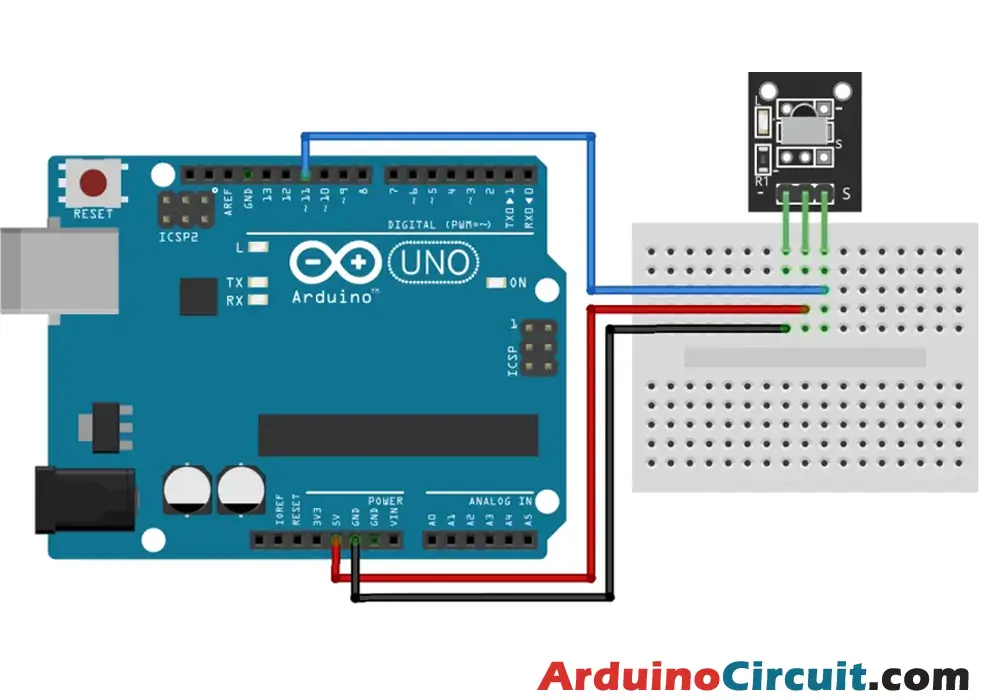Introduction
The KY-022 Infrared Receiver module is an electronic component that can receive and decode infrared signals. This module is widely used in remote control systems and other electronic applications that require the transmission and reception of infrared signals. It is an essential component in electronics and can be easily integrated with other electronic components to create a range of applications.
This module is compatible with popular electronic platforms like Arduino, ESP32, Raspberry Pi, and other microcontrollers. This module can also be operated with the KY-005 IR Transmitter module.
Hardware Required
You will require the following Hardware Components for interfacing the KY-022 Infrared Receiver module with arduino.
| Components | # | Buy From Amazon |
|---|---|---|
| Arduino UNO | 1 | Buy Now |
| KY-022 Infrared Receiver module | 1 | Buy Now |
| Jumper Wires | 3 | Buy Now |
| Breadboard | 1 | Buy Now |
What is the KY-022 Infrared Receiver module?
The KY-022 Infrared Receiver module is an electronic component that can receive and decode infrared signals. The module is composed of a PCB board, an infrared receiver, a resistor, and a few other electronic components. The module can receive infrared signals from remote controls or other infrared transmitters and decode them into digital signals that can be read by a microcontroller or other electronic components.

Specifications
The module is composed of an 1838 IR receiver, a PCB board, an LED, a 1kΩ resistor, and 3 male header pins.
| Operating Voltage | 2.7V to 5.5V |
| Operating Current | 0.4mA to 1.5mA |
| Reception Distance | 18m |
| Reception Angle | ±45º |
| Carrier Frequency | 38KHz |
| Low-Level Voltage | 0.4V |
| High-Level Voltage | 4.5V |
| Ambient Light Filter | up to 500LUX |
Features
- High sensitivity to infrared signals
- Easy to integrate with other electronic components
- Affordable and widely available
- Low power consumption
- Supports a range of remote control protocols
Pinout

Pin Configuration
| Pin Name | Pin Type |
|---|---|
| S | Signal |
| middle | VCC |
| – | GND |
Circuit Diagram
The following circuit shows you the connection of the KY-022 Infrared Receiver module with Arduino Please make the connection carefully

Circuit Connections
| Arduino | Module |
|---|---|
| Pin 11 | S Pin |
| +5V | middle Pin |
| GND | (-) GND Pin |
Installing Arduino IDE Software
First, you will require to Download the updated version of Arduino IDE Software and Install it on your PC or laptop. if you Learn How to install the Arduino step-by-step guide then click on how to install Arduino Button given Blow
Installing Libraries
Now when you are Ready to upload the code, to the Arduino Board you will need first to add the Following Libraries in Arduino, If you Learn How to add the library in the Arduino step-by-step guide click on how to install the library Button given Blow.
Code
//For more Projects: www.arduinocircuit.com
#include <IRremote.h>
int RECV_PIN = 11; // define input pin on Arduino
IRrecv irrecv(RECV_PIN);
decode_results results; // decode_results class is defined in IRremote.h
void setup() {
Serial.begin(9600);
irrecv.enableIRIn(); // Start the receiver
}
void loop() {
if (irrecv.decode(&results)) {
Serial.println(results.value, HEX);
irrecv.resume(); // Receive the next value
}
delay (100); // small delay to prevent reading errors
}Applications
- Remote control systems
- Smart homes and home automation
- Industrial automation
- DIY electronic projects
- Consumer electronics
Conclusion
The KY-022 Infrared Receiver module is an essential electronic component that can receive and decode infrared signals. With its high sensitivity to infrared signals, easy integration with other electronic components, and support for a range of remote control protocols, it is a popular choice for remote control systems, smart home automation devices, industrial automation systems, and DIY electronics enthusiasts. Whether you’re building a remote control system or a smart home automation device, the KY-022 Infrared Receiver module is a versatile and useful component that can help bring your projects to life.





